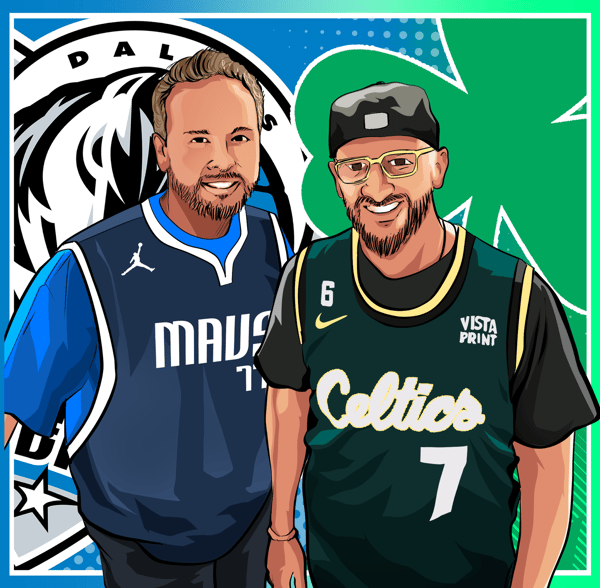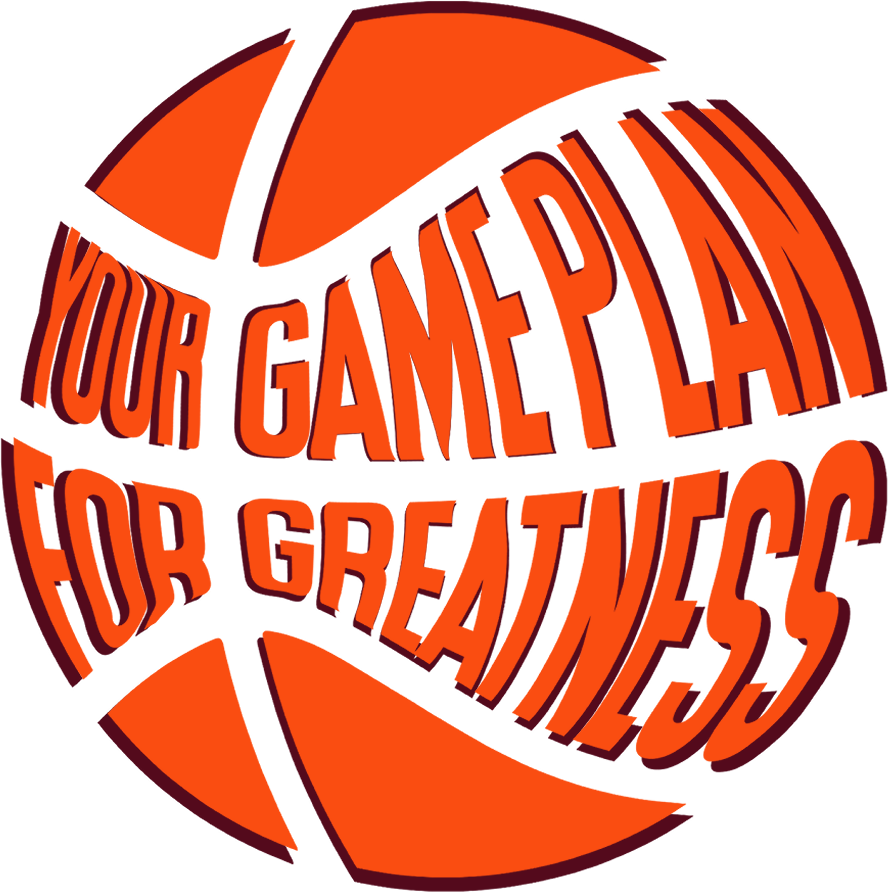Table of Contents
Pregame Warmup
Before you get further, we need to warn you: This is about to get sporty. We’re taking The Compass to the hardwoods for 2025, and here’s why:
Nonprofit marketing and fundraising is a team sport. It takes many moving parts working together to achieve success, and each individual must put the mission ahead of their personal goals.
Like hoops, fundraising is changing right in front of our eyes. Consider the notes below about the evolving landscape. On the court, there’s a new era of gameplay, maximizing length, volume and efficiency. Sounds a lot like nonprofit direct marketing to us.
Frankly, our favorite basketball teams met in the NBA Finals last year. While only one came away victorious, we’re constantly enthralled by the chess game of basketball. We believe there’s much to learn from the sport and apply to fundraising practices.
So, grab your sneakers. Game on.
Ronnie Richard & Justin McCord

The State of Fundraising in 2025
The nonprofit sector continues to face both headwinds and opportunities as we move into 2025. Giving behaviors are shifting, the digital landscape is evolving rapidly, and new tools are emerging.
It’s a dynamic environment. Full stop.
Here’s a breakdown of the current state of fundraising:
Giving behaviors are shifting
The wealth distribution in the U.S. continues to impact philanthropy, with fewer donors giving, but those who do are contributing larger gifts.
Major donors and donor-advised funds (DAFs) are driving significant revenue, but relying on large gifts alone is risky. Building a sustainable future means focusing on mid-level donors and growing your monthly sustainer base.
New tools and tactics
Donor-advised funds (DAFs) are growing at a record pace and present a major opportunity for nonprofits willing to engage strategically.
Monthly giving remains the cornerstone for reliable, recurring revenue. Building a healthy pipeline with mid-level donors is critical to sustaining growth long term.
A changing digital landscape
New platforms are fragmenting digital attention, with social media reshuffling audiences faster than ever.
Privacy updates from Apple, Google and other tech giants are changing how we target and measure success.
One thing remains clear: video, video, video. Audiences crave authentic, real-time storytelling across platforms.
Put it all together, and it’s clear that nonprofit leaders must focus on adaptability, teamwork and innovation to succeed.
Executing the Winning Playbook
The Nonprofit Marketer’s Compass is here to guide you through this ever-changing landscape. In 2025, we’ll focus on four pillars to help you prioritize and thrive:
- Put on Your Socks
- Perfect Your Fundamentals
- Run the Offense
- Stretch the Floor

1. Put on Your Socks
If you’re not a hoops fan, the name John Wooden may not ring a bell. But if there were a Mount Rushmore of basketball coaches, it might just be four sculptures of Wooden.
The legendary basketball coach led UCLA to 10 national championships in a span of 12 years from 1964-1975. In 1977, the NCAA named its player of the year trophy the John Wooden Award.
It’s safe to say that Wooden knew a thing or two about leadership and success.
So how did he start each season with his players?
By showing them how to put on their socks.
Why? Because blisters from improperly worn socks could undermine everything his players worked for.
The moral of this story is this: It all starts with the foundation.
In fundraising, this principle is essential: Build your foundation before you start skyscraping.
Simplify your focus. Establish what’s important to your growth. Too often, nonprofits try to “do it all” and spread themselves too thin.
This isn’t about channels or creative or communication frequency. This is about taking a step back and starting with who you want to reach and what you want to say to them. This is about defining your audience.
Charitable giving trends show us two foundational audiences for modern fundraising: mid-level and sustainer giving. Mid-level giving serves as the pipeline for major gifts, and monthly giving provides the steady, predictable revenue needed to scale your mission. Both are critical to your success.
The key to growth in 2025? Start simple, start strong.

Your Gameplan from Jarred Schremmer
Know your audience. Read the room. Meet donors where they are.
We’ve all heard these sayings, but are we really being strategic about the experience we are giving our donors and prospects?
As an industry, we’ve used a handful of “tactics” that have us believing we are talking to our audience—like using their name and referencing their last gift—but we need to go further.
Think about your audience segments like relationships in your life. You can’t invest the same amount of time and effort into every relationship—you have to prioritize.
Family members: Maybe these are your high-value and monthly donors and prospects or your core (2+ years consecutive) donors.
Close friends: Maybe these are your mid-level and recurring donors or your transition (last year’s new or recaptured) donors.
Friendly neighbors: Maybe these are your engaged standard donors or your new or recently lapsed donors.
The number of segments will be unique to your program. Typically, we recommend starting with one of three approaches:
Donor Pyramid
Donor Lifecycle
Generational
Then, define your investment in each and establish your plan for what each segment should receive. Consider:
Which channels should you use?
What content/campaigns are relevant to them?
What type of content makes sense?
Where is more personal language needed?

2. Perfect Your Fundamentals
Tim Duncan, the five-time NBA champion for the San Antonio Spurs, earned the nickname “The Big Fundamental” for his relentless focus on getting the basics right.
Duncan wasn’t flashy—often choosing a bank shot off the backboard over a more satisfying swish—and he wasn’t a big personality in the locker room.
But he proved that small, consistent improvements lead to championships. His work ethic and constant drive to improve set the bar for his teammates.
One of Duncan’s mantras comes from a quote by St. Jerome that his mother taught him: “Good, better, best. Never let it rest. ‘Til your good is better and your better is best.”
In fundraising, optimization is your championship mindset.
Small gains matter. Following James Clear’s Atomic Habits principle, improving by just 1% every day makes you 37 times better by year’s end.
Stack your wins: Test, refine, and repeat. Focus on continuous improvement across:
- Landing page conversions
- Email open rates and clicks
- Direct mail response rates
- Sustainer retention metrics
The path to success in 2025 doesn’t require perfection overnight—it requires steady, incremental progress.

Your Gameplan from Thalamus “T” Hill
Most mature fundraising programs do some form of testing and optimization. But they often suffer from a similar challenge—a “bottom up” testing plan that focuses on tactical improvement and results in a high volume of tests.
Assuming your org faces this same challenge, can you clearly and concisely answer these two questions:
What did we learn this year?
How much value did those lessons add to our mission?
If not, you need to shift your focus toward a “top-down” learning agenda, with tests that can have a 20%+ impact on results. No two learning agendas are the same, but each should have five key activities:
Identify fundraising objectives: Leverage your donor file analytics to determine where you need to focus your program.
Analyze and audit: Review historic performance for each campaign and identify potential gaps.
Identify learning objectives: Determine the high-level questions that focus on each fundraising objective.
Design individual tests: Create hypotheses, identify testing variables and define success parameters.
Develop a roadmap: Plot tests against a schedule of deployment based around prioritization.

3. Run the Offense
The Chicago Bulls drafted Michael Jordan in 1984. He was an immediate star in his rookie season, and his name still resonates in today’s culture thanks to six NBA titles and a certain Nike shoe bearing his name.
What you may not realize is that it took Jordan six years of failure before winning his first title. You can chalk that up to maturity, roster and experience, but coaching and teamwork also played a big role.
Tex Winter was an assistant coach under Doug Collins from 1986 to 1989 with a bold offensive concept called the triangle offense. The strategy emphasized motion and passing to create easier scoring opportunities.
The magic? Every player, every action, worked in harmony to fit the bigger picture.
Collins wasn’t interested. At all.
When the Bulls hired Phil Jackson to replace Collins in 1989, Jackson fell in love with Winter’s triangle offense, and the rest—as they say—is history. Jackson and Winter also brought the offensive system with them to the Lakers, winning five more championships.
Fundraising and marketing must operate the same way.
Let your channels breathe: Email, social, direct mail and digital media should each play their role, but they must create a larger, connected experience for donors.
Most nonprofits over-focus on creative execution. While creative certainly matters, the real game-changer is data integration. Properly synced data ensures you deliver the right message, in the right place, at the right time.
Fundraising success is not a set of isolated tactics. It’s about how the pieces work together to create a complete, unstoppable strategy.

Your Gameplan from Matt DiBenedetti
DCO: Three little letters that can really help fundraisers score big.
Dynamic Creative Optimization (DCO) isn’t new, but it is seldom used to its fullest potential in fundraising. Through the use of strategically developed templated ad units, your organization can move away from a “one-size-fits-all" messaging approach.
DCO provides the ability to easily deliver personalized content that is data-driven and developed specifically for each audience segment to better relate to their interests. When content is more relatable, the donors you are aiming to reach are more likely to engage—yielding outcomes of higher performance in your fundraising and marketing efforts.
In order to “run the offense” well, you also need to take a page out of the previous pillar and “perfect your fundamentals.” This is the “O” of DCO—optimization. Here’s how it works:
Multitudes of content iterations are put in market at the same time (even testing multiple audience segments at once).
The DCO solution measures effectiveness and auto-removes any underperforming content.
Only the highest-performing versions for each audience are left in market.
When using this ability, it ensures that your media dollars are getting the most bang for their buck. Then, you can implement these rapid learnings in other channels to deliver the most effective experience for your donors.

4. Stretch the Floor
The American Basketball Association (ABA) started as a rival to the NBA in 1967. In order to stand out, they had to experiment a bit.
One bold idea they introduced was the 3-point shot, which quickly turned into a fan favorite. The two leagues merged in 1976, and the NBA introduced the 3-pointer in 1979.
But it didn’t take off right away among the players. For the first 15 years of the 3-pointer’s existence, players took fewer than 10 per game on average.
Thanks to unique players like James Harden and Steph Curry and innovative coaches like Mike D’Antoni and Steve Kerr, NBA teams in the last 15 years began to realize the value of stretching the floor with deeper shots. Similarly, Caitlin Clark is redefining the women’s basketball game with her range and creativity.
Last season, the number of 3-point attempts per game soared to 35.1.
Today, offensive scoring is at an all-time high, and young kids are wanting to shoot threes more than they want to dunk. It’s a whole new era that was sparked with experimentation and a little bit of patience.
Nonprofits can learn from this bold innovation: Stretch your floor and embrace emerging trends.
Explore new opportunities: We live in a world of infinite possibilities when it comes to communication. Never before in history have you had so many ways to share your story with supporters.
Expand your reach with creative innovation: Test new content formats, leverage video storytelling, and build campaigns that resonate across evolving platforms.
Success in 2025 requires organizations to take smart risks, embrace innovation and think beyond the traditional playbook.

Your Gameplan from Jenn Thompson
This is all about trying new things, so there’s no right or wrong answer for “stretching the floor” in fundraising.
Depending on your organization’s size or maturity level, you may be trying some of the suggestions below already. Or maybe you’ve thought about it but haven’t taken the leap yet.
In either case, don’t be afraid to fail. Take the chance on something new.
Here are a few ideas:
SMS and in-app messaging are becoming powerful ways to engage donors directly.
Connected TV allows for digital media to meet donors where they stream.
Don’t forget about donor-advised funds (DAFs), which are quickly becoming an essential part of reaching high-capacity donors.
Test out newer social media channels like TikTok, Threads and BlueSky, and try new capabilities like Instagram Reels and YouTube Shorts in existing platforms.
In the world of AI and bots, donors crave something real, and GoFundMe crowdfunding is real competition for fundraising dollars. Lean into authentic storytelling, especially in video.
Monthly donors are your most valuable. Stretch their giving by including them in key regular appeals like special matches or year end.
Tribute giving can help expand your bench—a sixth man to pull in new donors.

The Final Buzzer
The path to growth in 2025 begins with focus and evolves through strategy. By strengthening your foundation, aligning your channels, perfecting the basics and exploring emerging opportunities, your nonprofit will be well-positioned to thrive in the year ahead.
Remember, the best teams don’t rely on talent alone—they execute, adapt and innovate.
This year, let The Compass guide your way as you look to stack up win after win. Your mission—and your donors—deserve nothing less.
.png?width=800&height=400&name=RKD-logo-red-tm%20(1).png)
SHARE